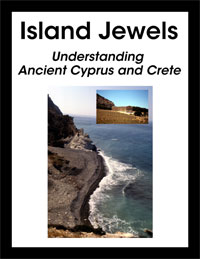Editor’s Note: This blog article contains images of human skeletal remains.
In one of the most impressive Mediterranean discoveries ever made, the University of Gothenburg’s expedition at Hala Sultan Tekke, on the southern coast of Cyprus, has unearthed a magnificent trove of over 500 items dating to the 14th century BCE, including fine bronze weapons, high-quality ceramics, semiprecious stones, and objects made from ivory and precious metals.
The Elite Tombs of Hala Sultan Tekke
“We found more than 500 complete artifacts distributed among two tombs,” said Peter M. Fischer, who has led the Söderberg expedition at the site since it began in 2010. The sheer quantity and richness of the grave goods appear to indicate that the tombs’ occupants enjoyed royal status in life, according to Fischer. Although the specific contours of the city’s social and political structure are not clear, “undoubtedly those buried here were part of the city’s government,” he said.
About half of the recovered objects—or the materials used to make them—were imported from other lands: Gold and ivory came from Egypt, turquoise from the Sinai Peninsula, lapis lazuli and carnelian from central and south Asia, and amber from the Baltic region far to the north. Most of the ceramic vessels came from Mycenaean Greece, with others originating in Anatolia (Turkey), Egypt, and the Levant.
The occupants of the tombs were men, women, and children. In addition to a variety of artifacts carefully arrayed around the human remains, beautiful diadems and necklaces adorned several of the individuals. The diadems are particularly impressive and boast embossed images of bulls, gazelles, lions, and flowers.
The tombs are located outside the ancient city and consist of a small passage leading to a series of underground chambers of various sizes, with the largest measuring about 215 square feet. They were discovered using magnetometers, which excavators used to identify large cavities several feet below the surface.
Cyprus is the easternmost land mass in the Mediterranean Sea. As the closest island to the Levantine coast, it was a crucial Bronze Age economic hub with ties to both Aegean and mainland Near Eastern kingdoms and cities. The ancient city at Hala Sultan Tekke was a major center for the copper trade between 1500 and 1300 BCE, thanks to the mines located in the nearby Troodos Mountains. Copper was a vital commodity because of its centrality in the making of bronze. These newly discovered objects are thus indicative of the immense wealth that flowed through the city.

Read more in Bible History Daily:
All-Access members, read more in the BAS Library:
Exploring Philistine Origins on the Island of Cyprus
Not a BAS Library or All-Access Member yet? Join today.The post Cypriot Tombs Yield Spectacular Treasures first appeared on Biblical Archaeology Society.
The post Cypriot Tombs Yield Spectacular Treasures appeared first on Biblical Archaeology Society.





0 Commentaires